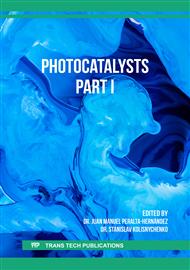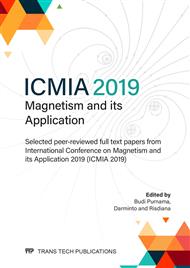[1]
Palkrisman., Budiman. A. (2014). Pemetaan Persentase Kandungan dan Nilai Suseptibilitas Mineral Magnetik Pasir Besi Pantai Sunur Kabupaten Padang Pariaman Sumatera Barat. Jurnal Fisika Unand, 3(4).
DOI: 10.25077/jfu.5.3.238-243.2016
Google Scholar
[2]
Ristic, M., Kuzmann.E., Homonnay.Z., Music.S. (2018). Synthesis and Properties of 1D Manganese-Doped Hematite Particles. Journal of Alloys and Compound, 767, 504-511.
DOI: 10.1016/j.jallcom.2018.07.115
Google Scholar
[3]
Yulianto, A., Bijaksana.S., Loesmanto.W. (2003). Comparative Study of Magnetic Characterization of Iron Sand from Several Locations in Central Java. Indonesian Journal of Physics, 14(2).
Google Scholar
[4]
Kooti, M., Sedeh, N. A., Motamedi, H., Rezatofighi. (2018). Magnetic grapheme oxide inlaid with silver nanoparticles as antibacterial an drug delivery composite. Applied Microbiology and Biotechnology. 102, 3607-3621.
DOI: 10.1007/s00253-018-8880-1
Google Scholar
[5]
Kirankumar, V. S., Sumathi, S. (2017). Photocatalytic and antibacterial activity of bismuth and copper co-dopped cobalt ferrite nanoparticles. Journal of Material Sciences:Materials in Electronics.
DOI: 10.1007/s10854-018-8890-x
Google Scholar
[6]
Legowo, B., Julica, B., Suharyana., Wijayanta, A. T., Purnama, B. (2018). Local distribution of the hematite content in a fine sediments of Bengawan Solo river. American Institute of Physics. 020122.
DOI: 10.1063/1.5054526
Google Scholar
[7]
Houshiar, M., Zebhi, F., Razi, J. Z., Alidoust, A., Askari, Z. (2014). Synthesis of cobalt ferrite (CoFe2O4) nanoparticles using combustion, coprecipitation, and precipitation methods: Acomparison study of size,structural,and magnetic properties. Journal of Magnetism and Magnetic Materials. 371, 43-48.
DOI: 10.1016/j.jmmm.2014.06.059
Google Scholar
[8]
Hutamanigtyas, E. (2016). Pengaruh Modifikasi Sintesis Terhadap Ikatan Oksida, Struktur Kristal, Dan Sifat Magnet Kobalt Ferit Hasil Kopresipitasi. Skripsi.
DOI: 10.12962/j24604682.v13i2.2298
Google Scholar
[9]
Purnama, B., Wijayanta A. T. & Suharyana. (2018). Effect of Calcination Temperature on Structural and Magnetic Properties in cobalt ferrite nano particles. Journal of King Saud University – Science.
DOI: 10.1016/j.jksus.2018.07.019
Google Scholar
[10]
Purnama, B., Legowo, B., Suharyana., Wijayanta, A. T. (2018). Annealing time effect of magnetic mineral in the Bengawan Solo River Fine-Sediment. 4th International Conference on Functional Materials Science 2018 (ICFMS 2018).
DOI: 10.1088/1757-899x/333/1/012017
Google Scholar
[11]
Kumar, R., & Kar, M. (2016). Lattice Strain Induced Magnetism in Substituted Nanocrystalline Cobalt ferrite. Journal of Magnetism and Magnetic Materials, 416, 335–341.
DOI: 10.1016/j.jmmm.2016.05.035
Google Scholar
[12]
Rana, K., Thakur, P., Sharma, P., Tomar, M., Gupta, V., & Thakur, A. (2015). Improved Structural And Magnetic Properties Of Cobalt Nanoferrites: Influence Of Sintering Temperature. Ceramics International, 41(3), 4492–4497.
DOI: 10.1016/j.ceramint.2014.11.143
Google Scholar
[13]
Setiadi, E., Pratiwi, S., & Purnama, B. (2019). Synthesis and characterization of MnxMg1-xFe2O4 based on natural iron sand prepared by Co-precipitation method. Journal of Physics: Conference Series, 1153, 012058.
DOI: 10.1088/1742-6596/1153/1/012058
Google Scholar



